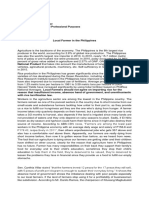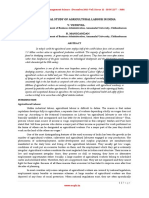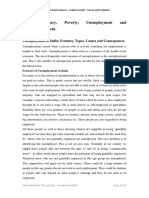Professional Documents
Culture Documents
Problems of Agricultural Labour in India
Uploaded by
jhansiCopyright
Available Formats
Share this document
Did you find this document useful?
Is this content inappropriate?
Report this DocumentCopyright:
Available Formats
Problems of Agricultural Labour in India
Uploaded by
jhansiCopyright:
Available Formats
Problems of Agricultural Labour in
India
As we are aware that near about 53% population of India is engaged in agricultural
activities. Here, the condition of the farmers and agricultural labourers depend on the
intensity of monsoon. Hence they are living an insecure and underprivileged life and
earning just Rs. 150/day along with full uncertainty.
As we are aware that near about 53% population of India is engaged in agricultural
activities. But agriculture in India is still at mercy of monsoon. Here, the condition of the
farmers and agricultural labourers depend on the intensity of monsoon. If monsoon is
good then crop is good and vice-versa. Agriculture labour is counted in the category of
unorganized sector, so their income is not fixed. Hence they are living an insecure and
underprivileged life and earning just Rs. 150/day along with full uncertainty.
The agricultural labourers are one of the most exploited and oppressed classes in rural
hierarchy.
Problems of Agriculture Labour:
1. Marginalisation of Agricultural Workers. The workforce in agriculture (cultivators plus
agricultural labourers) was 97.2 million in 1951 and this rose to 185.2 million in 1991. As
against this, the number of agricultural labourers rose from 27.3 million in 1951 to 74.6
million in 1991. This implies that (i) the number of agricultural labourers increased by
almost three times over the period from 1951 to 1991; Agricultural labourers increased
from 28 per cent in 1951 to 40 per cent in 1991. These facts indicate the fast pace of
casualisation of workforce in agriculture in India. Moreover, the share of agriculture and
allied activities in GDP at factor cost has consistently declined over the years - from 55.3
per cent in 1950-51 to 37.9 per cent in 1980-81 (at 1999-2000 prices) and further to 14.0
per cent in 2011-12 (at 2004-05 prices).
2. Wages and Income. Agricultural wages and family incomes of agricultural workers are
very low in India. With the advent of the Green Revolution, money wage rates started
increasing. However, as prices also increased considerably, the real wage rates did not
increase accordingly. Currently labours are getting around Rs. 150/day under the
MGNREGA in rural areas.
3. Employment and Working Conditions. The agricultural labourers have to face the
problems of unemployment and underemployment. For a substantial part of the year,
they have to remain unemployed because there is no work on the farms and alternative
sources of employment do not exist.
4. Indebtedness. In the absence of banking system in the rural areas and trial process of
sanction by the commercial banks, farmers prefers to take loans from un institutional
sources like Sahukars (moneylenders), landlords at the very high rate (in some cases at
40% to 50%) . This exorbitant rate traps in the vicious circle of debt.
5. Low Wages for women in Agricultural Labour. Female agricultural workers are
generally forced to work harder and paid less than their male counterparts.
6. High Incidence of Child Labour. Incidence of child labour is high in India and the
estimated number varies from 17.5 million to 44 million. It is estimated that one-third of
the child workers in Asia are in India.
7. Increase in Migrant Labour. Green Revolution significantly increased remunerative
wage employment opportunities in pockets of assured irrigation areas while
employment opportunities nearly stagnated in the vast rain fed semi-arid areas.
Measures Taken by the Government
1. Minimum Wages Act. The Minimum Wages Act was passed as long back as in 1948
and since then the necessity of applying it to agriculture has been constantly felt. Means
the Act is not applicable to agricultural sector?
2. Abolition of Bonded Labour. Since Independence, attempts have been made to
abolish the evil of bonded labour because it is exploitative, inhuman and violative of all
norms of social justice. In the chapter on Fundamental Rights in the Constitution of
India, it has been stated that trading in humans and forcing them to do begar is
prohibited and can invite punishment under the law.
3. Provision of housing sites. Laws have been passed in several States for providing
house sites in villages to agricultural workers.
4. Special schemes for providing employment. Rural Employment (CSRE), National Rural
Employment Jawahar Gram Samridhi Yojana (JGSY), and National Food for Work
Programme (NFFWP), Mahatma Gandhi Rural Employment Guarantee Act MGNREGA
5. Special agencies for development. Special agencies - Small Farmers Development
Agency (SFDA) and Marginal Farmers and Agricultural Labourers Development Agency
(MFAL) - were created in 1970-71 to solve the problems of Agriculture labour of the
country.
You might also like
- Position Paper About FarmerszDocument5 pagesPosition Paper About Farmerszcvcvxczv100% (2)
- Importance of Agribusiness in Indian EconomyDocument18 pagesImportance of Agribusiness in Indian EconomyAmanjit Kaur -SOBS50% (6)
- Keywords: Choice of Jurisdiction, Choice of Law, International Business Disputes in IndonesiaDocument32 pagesKeywords: Choice of Jurisdiction, Choice of Law, International Business Disputes in IndonesiaLee Xiang'sNo ratings yet
- Agricultural Labour: The Indian Agriculture, However, Has Its Own CharacteristicsDocument5 pagesAgricultural Labour: The Indian Agriculture, However, Has Its Own CharacteristicsYeshaswini RajshekarNo ratings yet
- Agriculture LabourDocument2 pagesAgriculture LabourDivya KanojiyaNo ratings yet
- 04 - Chapter 1Document14 pages04 - Chapter 1Krishna KumarNo ratings yet
- Child LabourDocument4 pagesChild LabourSampreethNo ratings yet
- The Agriculturist in Punjab: Agricultural LabourersDocument12 pagesThe Agriculturist in Punjab: Agricultural LabourersTanzeem ZeemiNo ratings yet
- An Empirical Study of Agricultural Labour in India PDFDocument6 pagesAn Empirical Study of Agricultural Labour in India PDFRaj RudrapaaNo ratings yet
- Organizing Agriculture Labour in IndiaDocument17 pagesOrganizing Agriculture Labour in IndiaArtika AshdhirNo ratings yet
- Agriculture IDocument4 pagesAgriculture ISyed Zuhayr ZamanNo ratings yet
- Agricultural Labour 501Document11 pagesAgricultural Labour 501Kailash SahuNo ratings yet
- Law and PovertyDocument13 pagesLaw and PovertyShimran ZamanNo ratings yet
- Agricultural Labourers and Related Labour Laws in IndiaDocument29 pagesAgricultural Labourers and Related Labour Laws in IndianithyaaNo ratings yet
- What AilsDocument6 pagesWhat AilsAbhay SinghNo ratings yet
- Farmers Distress and Agrarian Crisis in India - Converted - by - FreepdfconverterDocument4 pagesFarmers Distress and Agrarian Crisis in India - Converted - by - FreepdfconverterGurjotSinghNo ratings yet
- Agricultural Casual Wage WorkersDocument21 pagesAgricultural Casual Wage Workersalpana deyNo ratings yet
- 07 - Chapter 1Document18 pages07 - Chapter 1Krishna KumarNo ratings yet
- Poverty As A Challenge CWDocument3 pagesPoverty As A Challenge CWSanjay SwamynathanNo ratings yet
- Unemployment ArticleDocument7 pagesUnemployment Articledeepthi k thomasNo ratings yet
- IX - Economics NotesDocument10 pagesIX - Economics NotesSnehashree SahooNo ratings yet
- Unemployment)Document12 pagesUnemployment)Tanzeel KhanNo ratings yet
- Principles of Economics & Bangladesh EconomyDocument15 pagesPrinciples of Economics & Bangladesh EconomyEkla Pother PothikNo ratings yet
- B. Env. Unit 2 Part 3Document14 pagesB. Env. Unit 2 Part 3Priyanshu singhNo ratings yet
- Report On Routes To Livelihoods and Livelihoods DiversificationDocument3 pagesReport On Routes To Livelihoods and Livelihoods DiversificationSoumyajyoti MitraNo ratings yet
- Sem-3 ECO ASS.Document3 pagesSem-3 ECO ASS.IshaNo ratings yet
- Causes of UnemploymentDocument7 pagesCauses of UnemploymentBishwaranjan RoyNo ratings yet
- Agriculture LabourDocument13 pagesAgriculture Labouranon_255316492No ratings yet
- Economics Module 1 (AGRICULTURE)Document24 pagesEconomics Module 1 (AGRICULTURE)Ashvin RavriyaNo ratings yet
- Design Thinking Project Saloni Sunny C - PPTDocument12 pagesDesign Thinking Project Saloni Sunny C - PPTSunny AvlaniNo ratings yet
- Impact of MGNREGA On Food Security Asset Creation and IncomeDocument20 pagesImpact of MGNREGA On Food Security Asset Creation and Incomemarley joyNo ratings yet
- On Industrialisation in W.B. - Buddhadeb BhattacharjeeDocument6 pagesOn Industrialisation in W.B. - Buddhadeb Bhattacharjeesikha009No ratings yet
- SECOWW Plantation 200809Document86 pagesSECOWW Plantation 200809Naga RajNo ratings yet
- The Plight of Indian FarmersDocument15 pagesThe Plight of Indian FarmersGaurav SavlaniNo ratings yet
- Farming Has Lost The Ability To Be A Source of Subsistence For Majority of Farmers in IndiaDocument1 pageFarming Has Lost The Ability To Be A Source of Subsistence For Majority of Farmers in Indiakhup gwte100% (1)
- Agricutural Labourer MeaningDocument6 pagesAgricutural Labourer MeaningparimalamNo ratings yet
- Agri Unit 2.1Document19 pagesAgri Unit 2.1VAIBHAV VERMANo ratings yet
- 9 Most Essential Causes of Rural Unemployment in IndiaDocument10 pages9 Most Essential Causes of Rural Unemployment in IndiaAmit VijayNo ratings yet
- Challenges and Opportunities: Before The Agricultural Workers in Uttar PradeshDocument13 pagesChallenges and Opportunities: Before The Agricultural Workers in Uttar PradeshPoonam SharmaNo ratings yet
- Following Are The Objectives of Land ReformDocument22 pagesFollowing Are The Objectives of Land ReformLabib HasnainNo ratings yet
- Economics Last TopicDocument10 pagesEconomics Last TopicSushmitha AnanthNo ratings yet
- Poverty As A Challenge - NotesDocument4 pagesPoverty As A Challenge - NotesPrithik Chand ArunNo ratings yet
- According To World Bank, Poverty Is Pronounced Deprivation inDocument5 pagesAccording To World Bank, Poverty Is Pronounced Deprivation inDevyani Joshi 11 'A'No ratings yet
- Poverty and UnemploymentDocument10 pagesPoverty and UnemploymentJOSEPH HERBERT MABELNo ratings yet
- India 2012-Shining, UnequalDocument82 pagesIndia 2012-Shining, UnequalVikas SamvadNo ratings yet
- Indian Agriculture - An OverviewDocument16 pagesIndian Agriculture - An OverviewCA Kaushik Ranjan Goswami100% (3)
- Lec11 PDFDocument7 pagesLec11 PDFrahultelanganaNo ratings yet
- Disguised Unemployment in IndiaDocument5 pagesDisguised Unemployment in Indiamansinagpal2450% (2)
- EmploymentDocument10 pagesEmploymentEkta SivaprakashNo ratings yet
- 05-Karam SinghDocument19 pages05-Karam Singha-468951No ratings yet
- A Threat To Food SecurityDocument4 pagesA Threat To Food SecurityAc RaviNo ratings yet
- Article 21 Right To LivelihoodDocument19 pagesArticle 21 Right To LivelihoodShivam MishraNo ratings yet
- Agriculture in CovidDocument3 pagesAgriculture in CovidshreyaNo ratings yet
- Survives, India SurvivesDocument4 pagesSurvives, India SurvivesSurbhi ChaudharyNo ratings yet
- EmploymentDocument51 pagesEmploymentDuraiNo ratings yet
- Story of Village PalampurDocument2 pagesStory of Village PalampurComputer LearningNo ratings yet
- Agriculture and EconomyDocument4 pagesAgriculture and EconomyKanniha SuryavanshiNo ratings yet
- Agriculture HomeworkDocument19 pagesAgriculture HomeworkSiya SunilNo ratings yet
- HRD Unit - 1 (Tuition)Document20 pagesHRD Unit - 1 (Tuition)rishirocky636No ratings yet
- SST 9th Economics Lesson 3 NotesDocument3 pagesSST 9th Economics Lesson 3 NotesChaitanya SeriouskalhapureNo ratings yet
- Introduction To Anatomy & Integument - Notes (2023-08-10)Document14 pagesIntroduction To Anatomy & Integument - Notes (2023-08-10)jhansiNo ratings yet
- File 268Document80 pagesFile 268jhansiNo ratings yet
- Cast in Place ConcreteDocument19 pagesCast in Place ConcretejhansiNo ratings yet
- Economic Rights - IpleadersDocument24 pagesEconomic Rights - IpleadersjhansiNo ratings yet
- Aada: Aao: Ade: Adme: Adi: Adr: Adrs: Agdufa: Ahu: Alcoa: Alcoa PlusDocument10 pagesAada: Aao: Ade: Adme: Adi: Adr: Adrs: Agdufa: Ahu: Alcoa: Alcoa PlusjhansiNo ratings yet
- Meddra Coding: - Jhansi BogoluDocument18 pagesMeddra Coding: - Jhansi BogolujhansiNo ratings yet
- Gpat 2014 SolvedDocument12 pagesGpat 2014 Solvedjhansi100% (1)
- MPharmacy Syllabus 02072014Document106 pagesMPharmacy Syllabus 02072014jhansiNo ratings yet
- Least Cost System Operation: Economic Dispatch 2: Smith College, EGR 325 March 10, 2006Document37 pagesLeast Cost System Operation: Economic Dispatch 2: Smith College, EGR 325 March 10, 2006DalessandroNo ratings yet
- Chapter - 1: Richard GersterDocument80 pagesChapter - 1: Richard GersterSanjay ShankpalNo ratings yet
- Nested Control Structures (Visual Basic)Document3 pagesNested Control Structures (Visual Basic)Mohammad AliNo ratings yet
- SQL 2Document7 pagesSQL 2Mahendra UgaleNo ratings yet
- Employee Stock Option Scheme 2017 - 18 S - 1Document3 pagesEmployee Stock Option Scheme 2017 - 18 S - 1Mukesh PunethaNo ratings yet
- NR # 2484B 08.03.2011 - B - Probe On Government's Tenement Housing Program PushedDocument1 pageNR # 2484B 08.03.2011 - B - Probe On Government's Tenement Housing Program Pushedpribhor2No ratings yet
- Designing Data Analysis ProcedureDocument15 pagesDesigning Data Analysis ProcedureShadowStorm X3GNo ratings yet
- John Paulding MuseumDocument4 pagesJohn Paulding Museumapi-316020003No ratings yet
- Fra Fra CSV .NETFramework2.0SP1Document949 pagesFra Fra CSV .NETFramework2.0SP1Bruno VrielynckNo ratings yet
- Master Formula New UpdateDocument5 pagesMaster Formula New UpdateAdhoNo ratings yet
- Unit 5 - Week 4: Assignment 4Document4 pagesUnit 5 - Week 4: Assignment 4RITESH NANDANNo ratings yet
- What's The Tale Behind HL12?Document2 pagesWhat's The Tale Behind HL12?buy-hl12No ratings yet
- Report HRTP Sanofi PakistanDocument13 pagesReport HRTP Sanofi PakistanANUS AHMED KHANNo ratings yet
- Inspur Server BIOS User Manual V1.1Document154 pagesInspur Server BIOS User Manual V1.1albertoNo ratings yet
- A Smart Blind Stick For Aiding Visually Impaired PeopleDocument3 pagesA Smart Blind Stick For Aiding Visually Impaired PeopleInternational Journal of Innovative Science and Research TechnologyNo ratings yet
- Formatting TextsDocument3 pagesFormatting TextsCelestineNo ratings yet
- 09 Quotation For CC Kerb PDFDocument2 pages09 Quotation For CC Kerb PDFD V BHASKARNo ratings yet
- Big Data Tools-An Overview: ArticleDocument16 pagesBig Data Tools-An Overview: ArticleAdzan YogaNo ratings yet
- DD Form 2657 BlankDocument3 pagesDD Form 2657 BlankdavejschroederNo ratings yet
- Tutorial #4 KL4120 Offshore Platform Ocean Engineering ITB 2015Document26 pagesTutorial #4 KL4120 Offshore Platform Ocean Engineering ITB 2015Ockto Perdana SinagaNo ratings yet
- Mid Term Y2017 ACTL3151Document14 pagesMid Term Y2017 ACTL3151Zahid KhanNo ratings yet
- Chemical EquationsDocument22 pagesChemical EquationsSiti Norasikin MuhyaddinNo ratings yet
- Nouveau Document Microsoft WordDocument5 pagesNouveau Document Microsoft Wordlinakha186No ratings yet
- AgrrrraaDocument31 pagesAgrrrraaAnonymous apYVFHnCYNo ratings yet
- Da Series: Intelligent by DesignDocument2 pagesDa Series: Intelligent by DesignJames GrayNo ratings yet
- M123SP Service ManualDocument57 pagesM123SP Service ManualJhonatan Diaz100% (1)
- Project Protocol For Organic TeaDocument5 pagesProject Protocol For Organic TeaMuntaha ZyanNo ratings yet
- Transaction ManagerDocument52 pagesTransaction Managersatya_avanigadda69No ratings yet
































































































